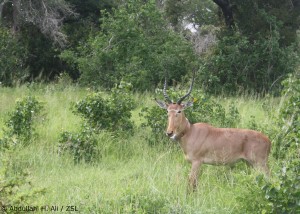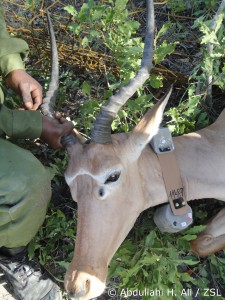 The hard work of EDGE Fellow Ali and the plight of the hirola has this week been recognised by the international press as news of the first ever attempt to GPS collar wild hirola in their native range reaches the UK.
The hard work of EDGE Fellow Ali and the plight of the hirola has this week been recognised by the international press as news of the first ever attempt to GPS collar wild hirola in their native range reaches the UK.Over the past thirty years, hirola numbers have plummeted by almost 90 percent, and they continue to decline. There are an estimated 400-500 hirola living today, but these animals continue to be severely threatened by a combination of drought, predation, poaching, and habitat loss. As the sole representative of its group, the loss of the hirola would be the first extinction of a mammalian genus on mainland Africa in more than 100 years.
Through a two-year EDGE Fellowship and as part of his PhD with the University of Wyoming, Ali is working to gain a better understanding of the range and ecology of the hirola as well as the reasons behind their ongoing population decline. Part of this work involves the tracking of the elusive hirola antelope with remote GPS-collars and Ali reported on the beginning of this work in an earlier blog.
Now, with the support of Ishaqbini Community Conservancy, the Kenya Wildlife Service and the Northern Rangelands Trust, a total of nine animals from seven different herds in north-eastern Kenya have been carefully captured and fitted with a GPS collar before being left to roam free once again.

The hirola collaring project was made possible by the support of: the Ishaqbini Community Conservancy, the Kenya Wildlife Service, the Northern Rangelands Trust, the Association of Zoos and Aquariums, Denver Zoo, Disney Wildlife Conservation Fund, Idea Wild, International Foundation for Science, Ms. Jennifer Speers, Mohamed Bin Zayed Species Conservation Fund, National Museums of Kenya, People’s Trust for Endangered Species, Rufford Foundation, St. Louis Zoo’s Center for Conservation in the Horn of Africa, University of Wyoming’s Berry Biodiversity Conservation Center, University of Wyoming’s Haub School of Environment and Natural Resources, and the Zoological Society of London
Kenya Wildlife Service
The Government of Kenya through Kenya Wildlife Service approved this study which has brought together a number of local and international partners.